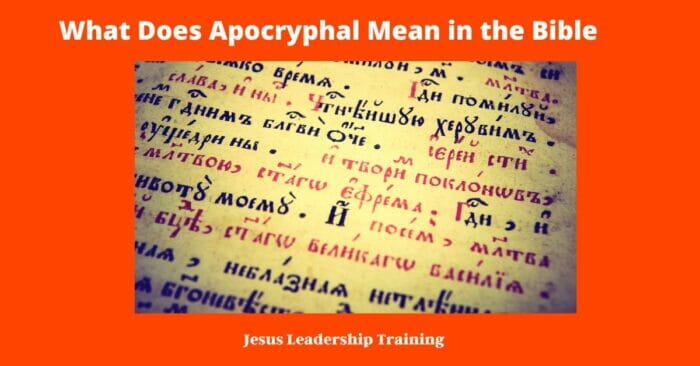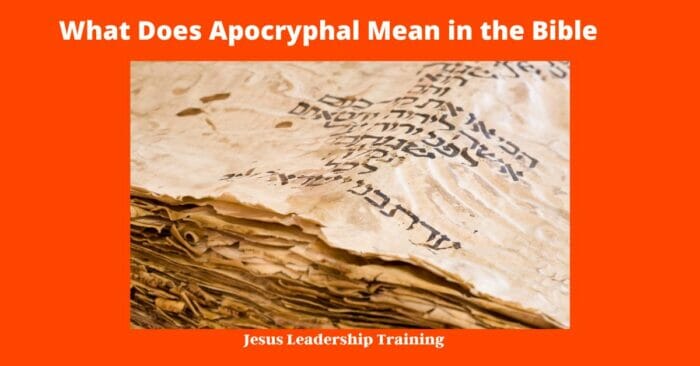What Does Apocryphal Mean in the Bible – The term “apocryphal” is used in the Bible to refer to a collection of books that are not part of the official canon of Scripture. These writings are not accepted by all Christian denominations, and their authenticity and reliability are often questioned. Apocryphal books are typically divided into two categories: the Old Testament Apocrypha and the New Testament Apocrypha.
The Old Testament Apocrypha includes works such as 1 and 2 Esdras, Tobit, Judith, the Wisdom of Solomon, and Baruch. The New Testament Apocrypha includes works such as the Gospel of Thomas, the Gospel of Philip, and the Acts of John. Apocryphal works are generally not used in the church and are not considered to be inspired by God, although they may have been written by early Christians. Apocryphal works are often used as a source of additional information and can provide insight into the beliefs and practices of the early Church.
Table of Contents
What Does Apocryphal Mean in the Bible
The Bible is one of the most widely read books in the world and it is full of interesting stories, teachings, and history. One of the more interesting parts of the Bible is the Apocrypha. The word apocrypha comes from the Greek word apokryphos, which means “hidden”. This refers to the books that are not included in the Bible but are still considered to be inspiring.
What Does Apocrypha Mean in the Bible
The Apocrypha is a collection of writings that were not included in the Bible but are still considered to be inspired. These writings were considered to be part of the Bible by some early Christian groups, such as the Septuagint, but were eventually excluded from the Bible.

How was the Canon of the Bible Determined and Why was the Apocrypha not Included
Throughout history, the Bible has been a source of comfort and guidance for many. But how did we get to the version of the Bible that we have today? The canon of the Bible, or the set of books used to determine which books should be included in the Bible, has been finely tuned since the early church. In this blog post, we will explore how the canon of the Bible was determined and why the Apocrypha was not included.
The process of determining the canon of the Bible began in the early church. During this time, the church fathers debated which books should be included in the Bible. They used criteria such as the book’s authorship, its relevance to the faith, and its acceptance by the Church at large to determine which books were included. The Church then developed a list of books that were accepted as canonical and those that were not.
The books of the Apocrypha were among those that were not included in the Bible. The Apocrypha contains several books that were written between 200 BC and 100 AD. Although these books were widely accepted in the early church, they were not included in the Bible because of their lack of relevance to the faith. The books of the Apocrypha are also not included in the Jewish canon and are not part of the Protestant Bible.

Today, the canon of the Bible is generally accepted as the 66 books of the Old and New Testaments. These books are accepted by both Catholics and Protestants, although there are some minor differences between their versions of the Bible. The books of the Apocrypha remain excluded from the Bible, although they are still widely read and studied for their historical and religious significance.
In conclusion, the canon of the Bible was determined by the early church after careful consideration and debate. The books of the Apocrypha were not included in the Bible because of their lack of relevance to the faith, although they remain widely read and studied for their historical and religious significance. The canon of the Bible today consists of the 66 books of the Old and New Testaments and is accepted by both Catholics and Protestants.
What the Apocrypha Books Reveal
The Apocrypha contains a variety of writings, including stories, poetry, and wisdom literature. These books provide insight into the Jewish and early Christian world, particularly in the areas of history, culture, and religion. They also provide us with a different perspective on some of the events described in the Bible.

How the Did Apostolic Fathers View the Apocrypha
The Apocrypha refers to a collection of books, or writings, found in some versions of the Bible. In the early Church, these writings were accepted as part of the canon of Scripture and were held in high regard. But how did the Apostolic Fathers view them?
The Apostolic Fathers were a group of Christian leaders who lived and wrote during the first and second centuries of the church. This group of Church Fathers included Clement of Rome, Ignatius of Antioch, Polycarp of Smyrna and others. They were important figures in the early Church and their writings have had a great influence on the development of Christian doctrine.
The Apostolic Fathers generally accepted the Apocrypha as part of the canon of Scripture. Clement of Rome, for instance, quotes from the Apocrypha in his epistles, and Ignatius of Antioch refers to the Apocrypha in some of his letters. They also wrote favorably of the books in the Apocrypha, particularly those that affirmed Christian beliefs and doctrines.
At the same time, the Apostolic Fathers had a more nuanced view of the books in the Apocrypha. They did not necessarily accept all the content of the Apocrypha as being divinely inspired or infallible. Some of the books in the Apocrypha, like the Book of Enoch and the Book of Jubilees, were not accepted by the church as Scripture. Likewise, some of the teachings in the Apocrypha were rejected by the church, such as the book of Tobit’s teaching on magic and astrology.
Overall, the Apostolic Fathers had a complex view of the Apocrypha. They accepted some of the books in the Apocrypha as part of the canon of Scripture, but not all of them. They held some of the teachings in the Apocrypha in high regard, but not all of them. Ultimately, the Apostolic Fathers viewed the Apocrypha much like the early church viewed the entire Bible: with respect and reverence, but also with caution and discernment.
Defining Apocrypha According to Webster’s Dictionary
According to Webster’s Dictionary, the definition of apocrypha is “writings or statements of dubious or uncertain authorship or authenticity; especially : writings collected as part of the canon of the Old Testament but not found in the Hebrew Bible”.
Resources for Studying Apocrypha in the Bible
There are a variety of resources available for studying the Apocrypha. These include books, websites, and Bible study guides. It is important to be aware of the various translations of the Apocrypha and to choose one that is reliable.
List of Reasons Translators Felt that The Apocrypha Were Not Inspired
- Apocryphal books were written centuries after most of the Old Testament, making them chronologically suspect.
- Many of the Apocryphal books contain teachings that are not found in the Old Testament canon and are not consistent with the teachings of the Bible.
- Apocryphal books contain historical inaccuracies and are not consistent with known facts about the ancient world.
- Apocryphal books contain doctrinal errors that contradict the teachings of the Bible.
- The Apocrypha was not accepted by Jesus and the apostles as inspired Scripture.
- The Apocrypha was not included in the Hebrew canon of the Old Testament, which was accepted by Jesus and the apostles.
- The Apocrypha was not accepted by the early church and the majority of Christians as inspired Scripture.
- The Apocrypha contains supernatural elements and stories that are not found in the Bible.
- The Apocrypha contains stories and teachings that are not consistent with the teachings of Jesus and the New Testament.
- The Apocrypha was not included in the earliest Greek manuscripts of the Old Testament.
Exploring the Apocryphal Books of the Bible
The Apocrypha contains a variety of books that are not found in the Bible but are still considered by some to be inspired. These books include 1 and 2 Maccabees, Tobit, Judith, Wisdom of Solomon, Ecclesiasticus, Baruch, and others. Each of these books provides insight into the Jewish and early Christian world.
Praying With the Apocryphal Books of the Bible
The Apocrypha can also provide a source of inspiration for prayer and meditation. Many of the books contain prayers and poems that can be used to reflect on the teachings of the Bible. Additionally, some of the books contain prayers that can be used to give thanks and seek guidance.
Using Online Resources to Learn About Apocrypha in the Bible
In addition to books and Bible study guides, there are also a variety of online resources available for studying the Apocrypha. These include websites and blogs that are devoted to studying and discussing the Apocrypha. These sites can provide additional insight into the books and their history.
List of all apocryphal books
The Apocrypha contains a variety of books, including 1 and 2 Maccabees, Tobit, Judith, Wisdom of Solomon, Ecclesiasticus, Baruch, and others.
List of the New Testament Apocrypha
- The Gospel of Thomas: This is a non-canonical gospel, likely written in the second century, attributed to the Apostle Thomas. It consists mainly of 114 sayings attributed to Jesus.
- The Gospel of Peter: This is a non-canonical gospel written in the second century and attributed to Peter, the disciple of Jesus. It includes stories of Jesus’ trial and crucifixion, as well as his resurrection.
- The Acts of Paul and Thecla: This is a non-canonical narrative written in the second century, attributed to Paul, the Apostle. It follows the adventures of Paul and his female companion, Thecla.
- The Epistle of Barnabas: This is a non-canonical letter written in the late first century, attributed to Barnabas, the companion of Paul. It includes teachings about the nature of Jesus and the Christian life.
- The Shepherd of Hermas: This is a non-canonical apocalypse written in the late first century, attributed to Hermas, a Christian prophet. It includes stories and parables about repentance and faith in Jesus.
- The Apocalypse of Peter: This is a non-canonical apocalypse written in the late second century, attributed to Peter, the disciple of Jesus. It includes visions of the afterlife and the day of judgement.
- The Epistle of the Apostles: This is a non-canonical letter written in the late first century, attributed to the apostles. It includes teachings about the end times and the coming of the Messiah.
- The Gospel of Mary: This is a non-canonical gospel written in the second century, attributed to Mary Magdalene. It includes stories of Jesus and his teachings.
- The Gospel of Judas: This is a non-canonical gospel written in the second century, attributed to Judas Iscariot. It includes stories of Jesus and his teachings, as well as the betrayal of Judas.
- The Apocryphon of James: This is a non-canonical gospel written in the late first century, attributed to James, the brother of Jesus. It includes stories of Jesus and his teachings.
List of the Old Testament Apocrypha
- The Book of Enoch (200-100 BC) – Authored by Enoch, the great-grandfather of Noah, this book describes the fall of the Watchers, angels who married human women. It also recounts Enoch’s visits to Heaven and Hell, and his revelations about the end of the world.
- The Book of Jubilees (150-100 BC) – Also known as the Little Genesis, this book is an attempt to rewrite the Bible’s book of Genesis. It provides an account of the world from creation to Moses, and includes an explanation of the calendar and laws. It is believed to have been written by an anonymous Jewish author.
- The Book of Tobit (200-100 BC) – This book tells the story of Tobit, a righteous Israelite living in exile in Nineveh. It includes a description of his suffering and his eventual redemption. It is believed to have been written by an anonymous Jewish author.
- The Book of Judith (100-50 BC) – This book tells the story of Judith, a beautiful and brave Jewish widow who saves her people from the Assyrian army. It is believed to have been written by an anonymous Jewish author.
- The Wisdom of Solomon (50-30 BC) – This book is an attempt to reconcile the idea of divine justice with the suffering of the righteous. It is believed to have been written by an anonymous Jewish author.
- The Book of Baruch (50-30 BC) – This book is an exhortation to repentance and a call for the recognition of the true God. It is believed to have been written by Baruch, a scribe in the court of King Jeremiah.
- The Letter of Jeremiah (50-30 BC) – This book is a letter written by the prophet Jeremiah concerning the idolatry of the Babylonians. It is believed to have been written by an anonymous Jewish author.
- The Prayer of Manasseh (50-30 BC) – This book is a prayer composed by King Manasseh of Judah. It is believed to have been written by an anonymous Jewish author.
- The First Book of Maccabees (100-50 BC) – This book is a historical account of the Maccabean revolt against the Seleucid Empire. It is believed to have been written by an anonymous Jewish author.
- The Second Book of Maccabees (50-30 BC) – This book is a historical account of the Maccabean revolt against the Seleucid Empire. It is believed to have been written by an anonymous Jewish author.
What Bibles Contain all apocrypha books
Not all Bibles include all of the apocryphal books. For example, the Catholic and Orthodox Bibles include all of the apocryphal books, while Protestant Bibles typically only include some of them, or exclude them.
In Greek Apocrypha What Does it Mean?
In Greek, the word “apocrypha” means “hidden”. This refers to books that were not included in the Bible, but are still considered to be inspired.
Why does apocrypha mean hidden
The Apocrypha was originally written in Greek and the word “apocrypha” means “hidden”. This refers to the fact that the books were not included in the Bible, but are still considered to be inspired.
Is Apocrypha mentioned in the Bible?
The Apocrypha is not mentioned in the Bible, but the books are still considered to be inspired.
What Does Apocrypha in the Bible Mean
The Apocrypha is a collection of books that were not included in the Bible but are still considered to be inspired. These books provide insight into the Jewish and early Christian world, particularly in the areas of history, culture, and religion.
What does Apocrypha Mean Biblically?
Biblically, the term apocrypha refers to books that are not included in the Bible but are still considered to be inspired. These books provide insight into the Jewish and early Christian world, particularly in the areas of history, culture, and religion.
Final Thoughts – What Does Apocryphal mean in the Bible
The Apocrypha is a collection of books that were not included in the Bible but are still considered to be inspired. The word “apocrypha” comes from the Greek word apokryphos, which means “hidden”.
These books provide insight into the Jewish and early Christian world, particularly in the areas of history, culture, and religion. They also provide us with a different perspective on some of the events described in the Bible. Additionally, the Apocrypha can provide a source of inspiration for prayer and meditation. There are a variety of resources available for studying the Apocrypha, including books, websites, and Bible study guides.




